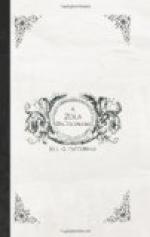As a study of artistic life the novel is full of interest. There is little doubt that the character of Claude Lantier was suggested by that of Edouard Manet, the founder of the French Impressionist school, with whom Zola was on terms of friendship. It is also certain that Pierre Sandoz, the journalist with an idea for a vast series of novels dealing with the life history of a family, was the prototype of Zola himself.
La Bete Humaine.
A novel dealing with railway life in France towards the close of the Second Empire. The hero is Jacques Lantier, the second son of Gervaise Macquart and August Lantier (La Fortune des Rougon and L’Assommoir). When his parents went to Paris with his two brothers, he remained at Plassans with his godmother, “Aunt Phasie,” who afterwards married Misard, a railway signalman, by whom she was slowly poisoned to secure a small legacy which she had concealed. After Jacques had passed through the School of Arts and Crafts at Plassans he became a railway engine-driver, and entered the service of the Western Railway Company, regularly driving the express train between Paris and Havre. He was a steady man and a competent engineer, but from his early youth he had been affected by a curious form of insanity, the desire to murder any woman of whom he became fond. “It seemed like a sudden outburst of blind rage, an ever-recurring thirst to avenge some very ancient offences, the exact recollection of which escaped him.” There was also in the employment of the railway company, as assistant station-master at Havre, a compatriot of Lantier named Roubaud, who had married Severine Aubry, the godchild of President Grandmorin, a director of the company. A chance word of Severine’s roused the suspicions of Roubaud regarding her former relations with the President, and, driven to frenzy by jealousy, he compelled her to become his accomplice in the murder of Grandmorin in an express train between Paris and Havre.




